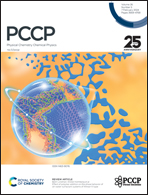Vacancy-mediated inelasticity in two-dimensional vanadium-based dichalcogenides†
Abstract
Amongst the two-dimensional (2D) transition metal dichalcogenide (TMDC) family, VX2 (X = S, and Se) are key members for next-generation electronic, spintronic, and energy storage applications. Structural defects may be introduced in these emerging atomically thin materials during synthesis, which can lead to both desirable and detrimental impacts on the physical and chemical properties. Owing to their brittle behaviour, defects may deteriorate the mechanical properties of 2D TMDCs drastically, causing reliability-related issues critical for long-term device-scale applications. In this context, more than 1600 classical molecular dynamics simulations were performed to obtain estimates of chirality-dependent failure stresses of 2D VX2 under technologically relevant conditions that are encountered in typical industrial and lab-scale experiments. The energy barriers associated with the fracture of defective samples were calculated using a thermal activation-based analytical model. Furthermore, the effect of various concentrations of randomly distributed defects on the mechanical reliability of VX2 samples was explored using two-parameter Weibull statistics. These monolayers were found to possess strong flaw tolerance and high Weibull modulus values, making them promising for flexible electronics and energy storage.



 Please wait while we load your content...
Please wait while we load your content...